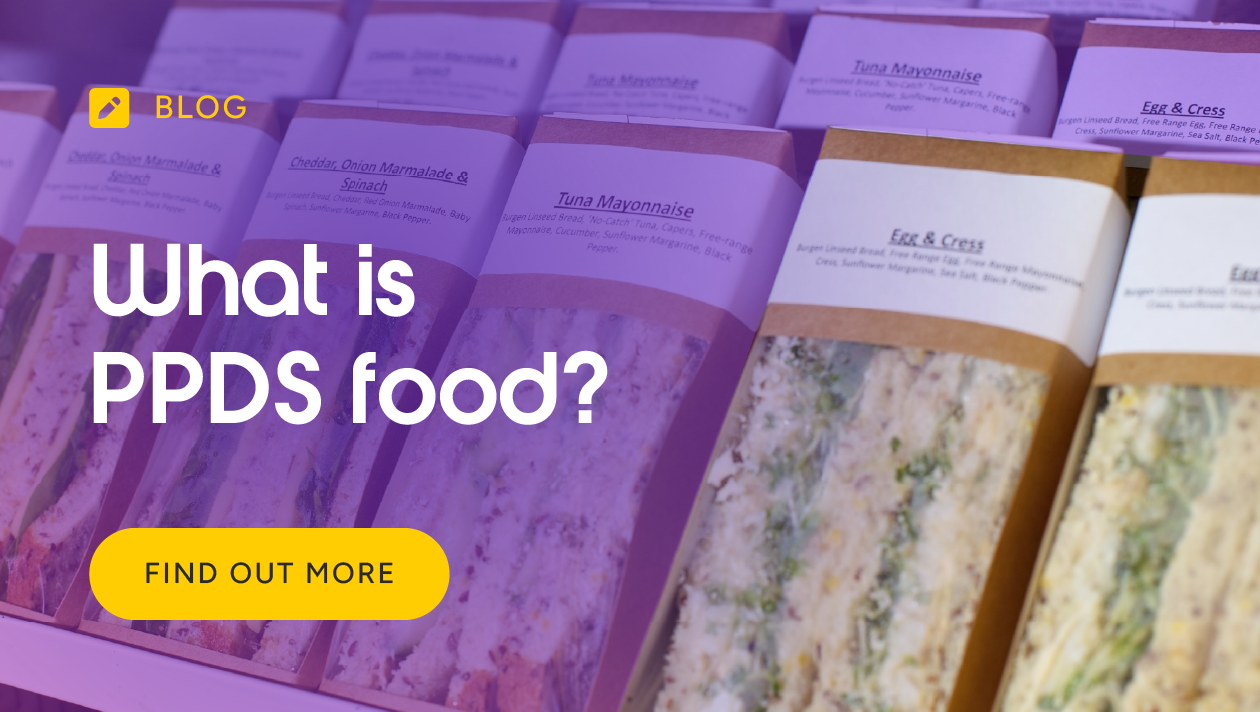What is PPDS food?
Posted 4 years ago

Food allergies are a serious cause for concern for many individuals who have to be incredibly careful about avoiding ingredients that could cause them serious harm. In fact, one in three people with known allergies have reported having an allergic reaction in a restaurant.
One way that the government has tried to mitigate these risks is by introducing laws that enforce the usage of food safety labels and allergen lists. This places a large responsibility on organisations that serve food, as they need to ensure that this information is made readily available to those who need it.
In this blog, we’ll go through everything you need to know about PPDS. From learning what it means, examples of PPDS food and what the laws state surrounding PPDS labelling. Giving you everything you need to keep your business and consumers safe.
What does PPDS mean?
PPDS stands for “pre-packed for direct sale,” which refers to any food item that is packaged before a customer orders it. These products must also have been packaged on the same site where they are sold. For example, sandwiches that are made in a kitchen are then packaged and sold over the counter.
A product may also be classified as PPDS if they have been packaged on one site and then transported to a temporary point of retail for the same business. For example, being moved to a food stall operating temporarily on a high street.
The packaging for a PPDS item doesn’t have to be fully enclosing it, but it must be sealed so that the product can not come into contact with an allergen after already being labelled.
PPDS legislation only applies to food products that have been packaged before they are selected. Items that are packaged after selection should have their potential allergens listed elsewhere and they should be consulted to the consumer before the purchase is made.
Examples of PPDS food
To truly understand what PPDS food is, let’s look at some common examples. These are items that are prepared and packaged on the same premises where they are offered for sale directly to the consumer:
- Sandwiches and wraps: Made fresh in-store and packaged for immediate purchase.
- Salad boxes: Prepared with fresh ingredients and packed by the staff for customers to grab and go.
- Pizzas: Made on-site, perhaps with various toppings, and then packaged without further cooking required by the consumer.
- Pasta pots: Cooked and portioned into containers ready for a customer to take away.
- Bakery items: Such as sausage rolls, pasties, and cakes that are baked and then individually packaged on the premises.
- Deli items: Olives, antipasti, and similar products that are pre-packaged into consumer-sized portions by the store.
- Meat and fish: That is prepared (e.g. marinated, portioned) and packaged by the business for direct sale from their counters.
- Snack pots: Containing a mix of fruit, vegetables, or nuts that are portioned and packaged by the business.
- Hot food: Like soup or stew that is made on-site and ladled into takeaway containers for immediate sale.
The crucial element in all these examples is the combination of being pre-packed and offered for sale directly to the consumer from the place it was made and packaged.
What isn’t PPDS classed as food
It’s equally important to understand what types of food do not fall under the PPDS regulations. This helps to clarify the scope and make sure that businesses are correctly identifying the food they sell:
- Food that is not pre-packed: This includes items served loose, where the customer can choose the quantity or have it assembled to order, such as a sandwich made to their specific requirements or a slice of cake cut from a larger one at the counter.
- Food packed by another business: Items that arrive at your premises already packaged by a different manufacturer or supplier, like a sealed bag of crisps or a branded yoghurt pot.
- Food packed at the consumer’s request: For example, if a customer asks for a specific amount of deli cheese to be weighed and wrapped for them.
- Food sold remotely: Items that are ordered online or by phone and then delivered to the customer. These are not offered for sale directly from the premises where they were prepared to the consumer on those premises.
- Food sold wholesale to other businesses: PPDS regulations are designed to protect the end consumer buying directly. Sales to other businesses for resale are not included.
- Food with minimal packaging for hygiene reasons: Items like unwrapped bread or single fruits displayed for sale are generally not considered PPDS, as the minimal covering isn’t the primary form of pre-packing for sale.
Understanding these distinctions is vital for food businesses to comply with labelling regulations and for consumers to know their rights regarding food information.
What are the Food Labelling Regulations?
As of 1st October 2021, food businesses must label PPDS food with:
- The name of the food
- A full list of ingredients
- Allergens emphasised (e.g. in bold, capitals, or underlined)
The law applies to the 14 major allergens such as milk, eggs, peanuts, tree nuts, gluten, soya, and sesame.
The name used should be the food’s legal name (if there is one), or a customary name (like ‘chicken caesar salad’). Additional descriptions can help clarify ingredients for the customer, especially in multi-component items like sandwiches or layered pots.
Businesses must also make sure that labels stay up-to-date with any recipe or supplier changes. It’s best practice to print labels digitally for clarity and consistency, avoiding handwritten information that may be hard to read.
Why was this change introduced?
These rules are sometimes referred to as part of Natasha’s Law, named after Natasha Ednan-Laperouse, a teenager who tragically died due to an undeclared allergen in a pre-packed sandwich. The changes aim to prevent similar incidents by making allergen information more visible and accessible to consumers.
Who is affected by the Food Labelling Regulations?
Any business in the UK that sells Pre-Packed for Direct Sale (PPDS) food must now comply with updated food labelling regulations, commonly referred to as Natasha’s Law. This law has been in force across England, Wales, Scotland, and Northern Ireland since 1st October 2021.
Businesses that are most likely to be affected include:
- Cafés and coffee shops
- Bakeries
- Delis and sandwich shops
- Market stalls and food vans
- Hospital canteens and school kitchens
- Supermarkets offering freshly prepared grab-and-go items
These types of businesses often prepare and package food on-site before it is selected by the customer – which falls directly under the PPDS category.
While restaurants and takeaways are less likely to sell PPDS food, they are still legally required to provide accurate allergen information for all menu items, whether written or verbal. Best practice also includes asking customers if they have any allergies when taking orders.
How do other countries comply with food regulations?
While Natasha’s Law is specific to the UK, other countries have their own systems for allergen labelling and food safety:
- European Union: The EU Food Information for Consumers Regulation (EU FIC) requires the 14 major allergens to be clearly identified on all prepacked foods, and allergen information must also be available for non-prepacked foods (e.g., in restaurants and cafés), usually verbally or via signage.
- United States: The Food Allergen Labelling and Consumer Protection Act (FALCPA) mandates labelling of 9 major allergens on packaged food, including sesame (added in 2023). Restaurants are not federally required to label allergens, though some states have introduced additional requirements.
- Australia & New Zealand: Under Food Standards Code 1.2.3, businesses must declare the presence of certain allergens on product labels, including gluten, milk, peanuts, and tree nuts. Allergen labelling is strictly enforced, and recent changes have made clearer formatting mandatory.
- Canada: The Canadian Food Inspection Agency (CFIA) requires allergen labelling for 11 priority allergens, gluten sources, and sulphites. Regulations cover prepackaged foods, with guidance also available for food service establishments.
Though approaches vary, the goal across all regions is the same, which is to protect consumers with allergies by providing clear, consistent allergen information on food products.
How to Comply with PPDS Food Labelling Regulations
Natasha’s Law requires all PPDS food to clearly display the following on its packaging:
- The name of the food that has been packaged
- A full list of ingredients that can be found in the product, including any of the fourteen key allergens
So, what needs to be put on a PPDS label?
If there are any allergens that are present in the ingredients, then they must be made clear by either putting the words in bold, increasing their size, or changing the font.
Additionally, the legal name of the food product must be displayed clearly on the packaging. Some food products have legal names in UK food law, such as jam, which requires a certain percentage of a particular ingredient to be legally classified as that food.
Food can also be labelled as its customary name, which is a name that has become accepted by the general public and requires no other description to let people know what it is. For example, a Caesar salad.
Organisations can also choose to add a description to the food product to provide more clarity about what is present. This can be particularly useful for products with multiple components, such as a sandwich.
It is the responsibility of the food retailers to ensure that ingredient lists are up-to-date and that changes to recipes are reflected. Food suppliers are legally required to give a full list of ingredients in any product they sell to a business, so food retailers should always have that information to hand.
It is also highly recommended that labels for PPDS products are digitally printed rather than hand written to bring consistency to the labels.
Online Food Allergy Awareness Training
Here at iHasco, we offer an Online Food Allergy Awareness Training course that is designed for individuals producing, selling or handling food. All staff handling food should have a thorough understanding of allergens and the potential dangers surrounding them.
However, with Natasha’s law being enforced from the 1st October 2021, we will be launching an updated version of this course between the 16th-22nd September that will include key legislative updates, including PPDS changes.
To find out more about our course and Natasha’s law, then please read our blog.
Alternatively, you can request a bespoke quote for your organisation today!

Jack Rosier
Senior Marketing Executive
Related articles



Opt-in to our newsletter
Receive industry news & offers